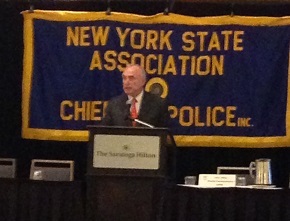By Leischen Stelter, editor of In Public Safety
At the New York State Association of Chiefs of Police annual gathering of police chiefs from around the state, police commissioner of New York City William Bratton provided his perspective on the current state of policing in the country.
“The last 18 months has been a time of extraordinary challenges and opportunities for the profession,” said Bratton. “We have a new world of issues that we need to deal with, but there’s an old world of issues that are resurfacing.”

Bratton, whose law enforcement career spans more than 45 years, encouraged chiefs to learn from the past and not allow the profession to repeat the same mistakes.
“The world I came into as a young officer in the 1970s was in great turbulence with civil rights and issues of racial inequality,” he said. “There was great political unrest and rising crime…It feels like déjà vu all over again.”
One of the primary mistakes law enforcement made during that time period was focusing on responding to crime rather than focusing on the causes of crime and trying to prevent crime. This shift from prevention to response, coupled with officers being taken off beats and put into cars to cover larger areas, all contributed to the disengagement of officers with the public. This approach negatively impacted community relationships and its impact became evident across the country with high publicity protests and riots.
During his keynote, Bratton shared a plan that will continue fighting crime, but also help bridge the gap between police and minority communities and rebuild police morale. Bratton highlighted five strategic areas, referred to as the “5 Ts”, which form the foundation and focus of this plan.
Rebuilding Trust
One issue that has publicly and violently resurfaced around the country is the issue of trust, specifically the lack of trust of law enforcement officers and agencies by the public. This loss of confidence in policing stems around issues of race and police practices, as highlighted in riots in Ferguson and Baltimore.
This lack of trust goes beyond a loss of confidence in local agencies, said Bratton. The public has lost trust in the criminal justice system as a whole. For example, many people do not trust that district attorneys will pursue police-abuse allegations appropriately.
All of this needs to change, said Bratton. He emphasized that police chiefs need to work hard to rebuild community trust. “Going forward we must gain trust by winning back the communities we lost or never had,” he said. Reinstituting community policing practices is a good start and can help build stronger bonds between officers and community members.
[Related Article: Strong Community Relations Among the Lessons of Ferguson]
Chiefs also need to look inside their own departments to rebuild internal trust and boost officer morale. “Our police officers feel damaged by all of this and the morale in departments has suffered significantly,” he said. “Chiefs must work to rebuild trust of the community, of political leadership, of the media, and of police officers themselves.”
Fighting Terrorism
Another area of focus involves law enforcement’s role in the fight against terrorism. “American policing now has to spend a lot of time on a new form of crime: terrorism,” he said. Bratton said the NYPD has tactically trained and specially equipped 400 of its officers to protect and prevent a terrorist threat “in the likely event of an incident,” he said.
With the upsurge in terrorist attacks throughout the country and around the world, Bratton is realistic about the likelihood of more armed terrorist attacks in the city. “We want to have the capability and resources to respond quickly,” he said. One of the keys to fighting terrorism is training officers to be able to constantly and quickly adjust to unpredictable situations.
Embracing Technology
The effective use of technology is another focus of the NYPD. “Technology keeps officers better informed in the field,” he said. Soon, all 35,000 NYPD officers will be equipped with smartphones and tablets that have custom apps so officers have instant access to information. “No officer will have to come back to the station to work on a computer—they can do it all from the car,” he said.
Bratton also discussed the use of body-worn cameras. “It’s not the panacea like we want it to be, but it’s a great boon to policing,” he said. This technology is helping verify officer’s actions. “Policing is going to benefit from this technology, but the public and the profession don’t fully understand it yet,” he warned.
Training and Tackling Crime
Bratton also discussed the last two “T’s” of his plan: training and tackling crime. NYPD has a focus on enhanced training for officers as well as a plan to tackle crime by re-establishing community policing strategies.
Bratton’s parting message to the New York chiefs in attendance was one of future sharing and partnership. “At the NYPD we consider ourselves one of the country’s largest laboratories for policing,” he said. “We have a lot of resources that we’ve never had before and we have the ability to work with the leadership to improve the performance of our department and we will share those findings with you.”